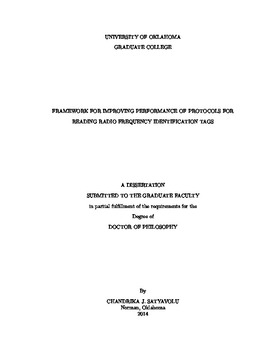| dc.contributor.advisor | Radhakrishnan, Sridhar | |
| dc.contributor.author | Satyavolu, Chandrika | |
| dc.date.accessioned | 2014-12-12T18:53:59Z | |
| dc.date.available | 2014-12-12T18:53:59Z | |
| dc.date.issued | 2014-12-12 | |
| dc.identifier.uri | https://hdl.handle.net/11244/13882 | |
| dc.description.abstract | Radio-frequency Identification (RFID) is a highly sought-after wireless technology used to track and manage inventory in the supply chain industry. It has varied applications ranging from automated toll collection and security access management to supply chain logistics. Miniaturization and low tag costs of RFID tags have lead to item-level tagging, where not just the pallet holding products is tagged but each product inside has a tag attached to it. Item-level tagging of goods improves the accuracy of the supply chain but it significantly increases the number of tags that an RFID reader must identify and track. Faster identification is crucial to cutting cost and improving efficiency.
Existing RFID protocols were designed to primarily handle static scenarios with both RFID tags and readers not being in motion. This research addresses the problem of inventory tracking within a warehouse in multitude of scenarios that involves mobile tags, multiple readers and high density environments. Mobility models are presented and frameworks are developed for the following scenarios: a) mobile tags on a conveyor belt with multiple fixed readers; b) mobile reader in a warehouse with stationary tags in shelves; and c) high density tag population with Near-Field (NF) communication.
The proposed frameworks use information sharing among readers to facilitate protocol state handoff and segregation of tags into virtual zones to improve tag reading rates in mobile tag and mobile reader scenarios respectively. Further, a tag’s ability to listen to its Near-Field neighboring tags transmissions is exploited to assist the reader in resolving collisions and hence enhancing throughput. The frameworks discussed in this research are mathematically modeled with a probabilistic analysis of protocols employed in conjunction with framework.
With an increased number of tags to be identified, mathematically understanding the performance of the protocol in these large-scale RFID systems becomes essential. Typically, this analysis is performed using Markov-chain models. However, these analyses suffer from the common state-space explosion problem. Hence, it is essential to come up with a scalable analysis, whose computation model is insensitive to the number of tags. The following research analyzes the performance of tag identification protocols in highly dense tag scenarios, and proposes an empirical formula to estimate the approximate time required to read all the tags in a readers range without requiring protocol execution. | en_US |
| dc.language | en_US | en_US |
| dc.subject | Computer Science | en_US |
| dc.subject | RFID protocols | en_US |
| dc.subject | Wireless Networks | en_US |
| dc.title | FRAMEWORK FOR IMPROVING PERFORMANCE OF PROTOCOLS FOR READING RADIO FREQUENCY IDENTIFICATION TAGS | en_US |
| dc.contributor.committeeMember | Commuri, Sesh | |
| dc.contributor.committeeMember | Atiquzzaman, Mohammed | |
| dc.contributor.committeeMember | Kim, Changwook | |
| dc.contributor.committeeMember | Lakshmivarahan, S | |
| dc.date.manuscript | 2014-11-03 | |
| dc.thesis.degree | Ph.D. | en_US |
| ou.group | College of Engineering::School of Computer Science | en_US |
